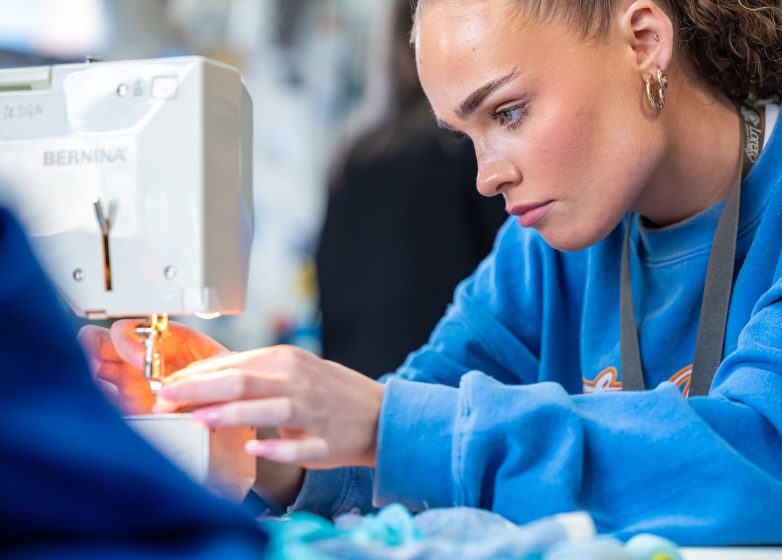Entry Requirements
- Six GCSEs 9-4 (or A*-C)
- Two from English, Maths OR Science
- Two at least grade 6
Course specific requirements:
GCSE grade 9-4 in Art or any design-based subject OR portfolio of work if no GCSE Art .
For full guidance on portfolio requirements, click here
Portfolio example: click here
Please send any enquiries to the subject email: [email protected]

A Level Fashion & Textiles
- Do you want to unleash your creativity and make a mark in the world of fashion?
- Are you ready to dive into the fascinating world of textiles, where you can learn innovative techniques to transform fabric into captivating works of art?
A Level Fashion and Textiles is an art-based subject with an emphasis on creativity and innovation. Projects are devised to help students understand the fundamental process of design through research, sampling and developing ideas into unique and exciting outcomes.
Exam board: OCR
Components
Component 1: personal investigation
Percentage of total mark: 60% of total A Level
You will produce two elements:
- A portfolio of practical work showing your personal response to either a starting point, brief, scenario or stimulus, devised and provided by the learner or centre.
- A related study: an extended response of a guided minimum of 1000 words.
Component 2: externally set task
Percentage of total mark: 40% of total A Level
You will respond to an externally set task which will provide a number of starting points. A response will be based on one of these options
Skills and opportunities
You will experiment with a range of materials and techniques, including embroidery, fabric manipulation, printing, dyeing and digital design to create interesting surface patterns and textures that can be developed into garments, accessories, functional objects or pieces of art in relation to a set or chosen theme.
You will have opportunities to enter national competitions and exhibit work offsite. You can also apply to undertake roles of responsibility in the department such as Subject Ambassador or become a member of the Art Collective.
Careers/destinations
This subject would appeal to students who are interested in careers in fashion design, textile design, fine art, interior textile design, costume and theatre design and other related careers such as fashion marketing, styling, journalism, communication, promotion and business.
Textile Design
What GCSE subjects do I need to study Textile Design?
If you have studied Art, Textiles, Design Technology, Graphics, Photography or any other art-based subject then you would need to have gained a grade 4 or above.
Is this a fashion course? Will I learn how to make clothes?
The official title of the course is Textile Design. However, the majority of students taking the course have a strong interest in fashion so many opportunities are provided to produce work of this nature. Students with more of an interest in textiles, art or interiors can equally develop work toward these kinds of outcomes.
Can I study Textile Design if I haven’t got a GCSE in an art based subject?
Yes, it is possible, but we would like to see some examples of your work. These can be textile samples that you have made from watching online tutorials or surface pattern design ideas created through painting/collage/mark-making. You should bring these examples with you when you come enrol at the start of the year.
Do I need to have done textiles before? Do I need to know how to use a sewing machine?
Experience in textiles is not required before starting the course; basic technical skills are taught in the first term. It is more important that you have experience in art and design, or are at least open to working in an art and design manner as opposed to technology.
If I study Textile Design what could I then go on to study at University and beyond?
After studying Textile Design at Loreto students often progress to
onto courses and careers including Fashion Design, Textile Design,
Fine Art, Fashion Marketing, Fashion Journalism, Fashion Business,
Costume Design, Media, Photography, Dentistry and Medicine (studying textiles demonstrates fine-motor skills required for medical courses). Even English, History and Politics are popular progressions! (The research, contextual and conceptual aspects of the textiles course compliment these subjects well.)
Is the course an A Level? Does the course have an exam?
The course is a full A level studied over two years alongside two
other A Level courses. It is 100% course work. You will have to sit a
15-hour exam at the end of your second year, but this is a practical
exam.
What do you do on the course?
In Lower sixth, you will learn a wide range of techniques and processes including machine and hand embroidery, printing, dyeing, fabric manipulation and digital patterning in response to different set themes. Following this, you will begin a Personal Investigation project developed from your own lines of research and inquiry which is worth 60% of your total A Level mark. The majority of this project is practical, but you are also required to complete a 1000 – 3000 word written study. The final stage of the course is your Externally Set Assignment worth 40% of your total A Level mark which requires you to sit a 15-hour practical exam following a period of research and development.
How many students are in a class?
This varies from year to year, but currently class sizes are never more than 20 students.
What other subjects could I study alongside Textile Design?
Students aiming for a career in art and design industries usually
study a second art subject to build a stronger portfolio for
university interviews; fine art, photography, 3D design and graphic
communication. Other popular pairings include English, Media,
Film, Business, Biology and Chemistry.
